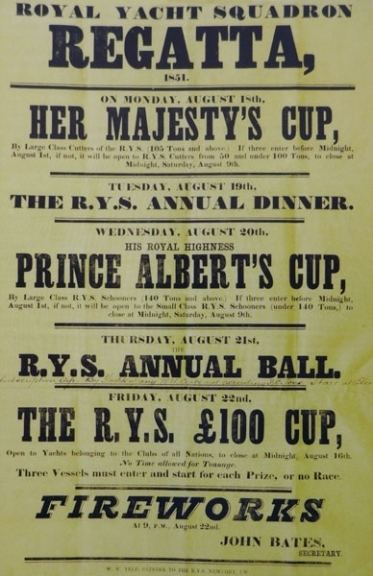Yacht: 'several' Dates: 22 August 1851 | ||
 | ||
The 100 Guineas Cup or Hundred Guinea Cup (£100 Cup) regatta of 1851 was the first competition for the America's Cup trophy. Originally, Cup of One Hundred Sovereigns, the value of the trophy was 100 pounds-sterling, hence its names, variations on 100 Pound Cup. The race was won by the yacht America, leading to the trophy being renamed "America's Cup". The 1851 competition was the first to compete for the trophy, hence the 1851 America's Cup or 0th America's Cup being zeroth, sequentially preceding the first America's Cup of 1870. The event "The America's Cup" would not be founded until 1857, when the deed of gift established the America's Cup racing regattas. The 1851 edition was a fleet race, unlike modern America's Cups finals, which are currently match races.
Contents
History
The race originated with an invitation for the Great Exhibition of 1851 by the Earl of Winton, then Commodore of the Royal Yacht Squadron (RYS), inviting the recently formed New York Yacht Club (NYYC) to enjoy the facilities of the clubhouse of the RYS. John Cox Stevens, Commodore of the NYYC responded positively, and anticipated racing. Due to the NYS rules of the time, other races in the 1851 RYS Regatta were restricted to RYS members and their self-owned yachts, so the R. Y. S. £100 Cup was established, open to anyone to enter. At a RYS meeting on 9 May 1851, the race was scheduled for 22 August 1851. This race was to be the first of a series of challenge races for successive £100 Cups. At the time, it was normal practise for the winners to own the cups that were won, and not to return them for the next race to be won by others.
The trophy
The trophy, worth 100 sovereigns in 1851, latterly affectionately known as the Auld Mug, distinguishing it from the racing regatta of the same name.
The trophy, a bottomless ewer, is made out of 134 oz (3.8 kg) of silver, and is 27 in (69 cm) tall. The ewer was a stock item obtained from jeweler Robert Garrard in 1848.
After the race it was engraved with the names of the yachts that raced against America, save the runner-up, Aurora.
The race
The regatta, held on 22 August 1851, raced clockwise around the Isle of Wight in a fleet race. The course was called "The Queen's Course". The course was near Cowes Castle on the Isle of Wight, where the Royal Yacht Squadron headquarters are located. The race took place as part of the 1851 Royal Yacht Squadron Regatta.
18 yachts were entered for the race, but only 15 yachts started the race. The yacht Fernande did not make the start, while Strella and Titania both got to the starting line, though did not start the race. Those yachts that raced were America, Alarm, Arrow, Aurora, Bacchante, Beatrice, Brilliant, Constance, Eclipse, Freak, Gipsy Queen, Ione, Mona, Volante, Wyvern
Aftermath
The trophy would be renamed "America's Cup" after the yacht America, that won the trophy. In 1857, the competition for "America's Cup" was declared, with the creation of the deed of gift. The first challenge would take place in 1870 under the deed of gift. This would initiate the oldest championship in sport.
